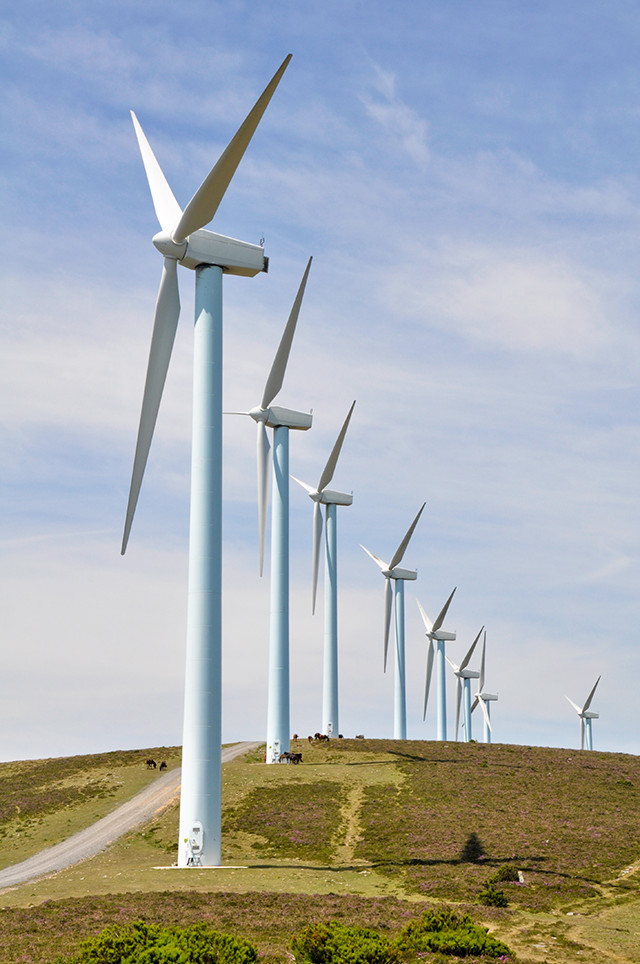
by Ward Chesworth Wednesday, April 13, 2016

Tilting at windmills is just as futile these days. credit: ©Shutterstock.com/NCG.
When you think of Spain, what images come to mind? The impoverished sailor from Genoa who was bankrolled by Queen Isabella to sail westward looking for China, but found a New World instead? The conquistadors who used guns, germs, steel and horses to topple two great civilizations? Or (my favorite) a fictional madman called Quixote who tilted at windmills?
For the Romans, Spain was the prize for defeating the Carthaginians in the second century B.C. It became a source of grain, gold, silver and even mercury, which all supported a growing empire. It was also where they found the “End of the Earth,” or “Finis Terrae” in Latin. It now appears on the map of Spain as “Finisterre” in Galicia, though the local Galegos with their Scottish-like reputation for parsimony shorten it to “Fistera.” The Romans named another Finisterre in France, although, interestingly, when they got to Britain and found Pedn-an-Laaz in Cornwall, they ignored the Cornish name, which literally means “Land’s End,” and called the exposed promontory “Bolerium,” the seat of storms. Go figure.
Though not literally the end of the Earth, of course, the coasts of Western Europe are still astounding for a different reason. They roughly mark the line along which the supercontinent Pangea was torn apa"t to produce the North Atlantic Ocean starting about 175 million years ago. Furthermore, the contorted rocks of northwestern Spain offer evidence of the latter stages of the massive collisions that assembled Pangea in the first place. The assembly closed an earlier “Atlantic” that geologists call Iapetus, after the son of Gaia and the father of Atlas in Greek mythology. In the Late Precambrian rocks of Norway, Scotland and the eastern Canadian Shield, there is evidence of an even earlier “Atlantic.” So, it looks as if Gaia plays a kind of slow-motion concertina with the ocean opening and closing on a billion-year timescale. I wonder if she knows “hat piece of music that every accordionist used “o play on the Ed Sullivan Show, “Lady of Spain.”
Last summer, I traveled to the Spanish Land’s End with two old friends and our respective daughters. It’s in the Province of Galicia, a place to enjoy marine invertebrates (aka seafood), washed down with “copas” of the sharp white wine made from locally grown Albariño grapes. What struck me on this trip was that one of the most obvious modifications of the landscape now taking place is the construction of wind turbines on every high ridge of Hercynian rocks that we passed on the road from Santiago de Compostela to Fistera. It’s a little ironic that this development is treated as a new alternative to fossil fuel as a source of power when windmills have been known in Europe for at least 800 years. Of course, the objective now is to generate electricity rather than to grind wheat and corn, saw wood, or pump water as in the past, and the current name “wind turbine” proclaims high-tech in a way that “windmill” never could.
To some, the qualifier “high-tech” strikes a forbidding note, and in spite of wind turbines being icons of clean energy they do attract opposition. Environmentalists object on such grounds as noise (frequency modulation in particular), bird-kills, and “visual pollution” of the landscape. One of the old friends with whom I was traveling, Antonio Martinez Cortizas, has a very specific concern: the destruction of the mires, or bogs, that blanket many of the ridges where the wind turbines are being built. Antonio is internationally known for his detailed studies of blanket bogs in northwestern Spain. He has shown that the bogs are a valuable archive of climate change going back some 8,000 years, and has used the geochemistry of lead and mercury in the peat from the mires to study the environmental history of the region over that period. He can show when the first farmers planted their crops in Neolithic times, when metal mining started in the Iberian peninsula, how the Roman economy fluctuated and finally collapsed, how the forests declined as Spain built and maintained the most powerful navy of the early modern period, and even how gasoline additives are reflected in modern peats.
These invaluable clues to climate change are currently being lost in the march of progress. Perhaps a latter-day Don Quixote will gallop up to give battle on Rosinante, his bag-of-bones steed. But remember, thanks to the original Man of La Mancha, “tilting at windmills” became a metaphor for futility. I don’t believe that “tilting at turbines” will be any different.
© 2008-2021. All rights reserved. Any copying, redistribution or retransmission of any of the contents of this service without the expressed written permission of the American Geosciences Institute is expressly prohibited. Click here for all copyright requests.